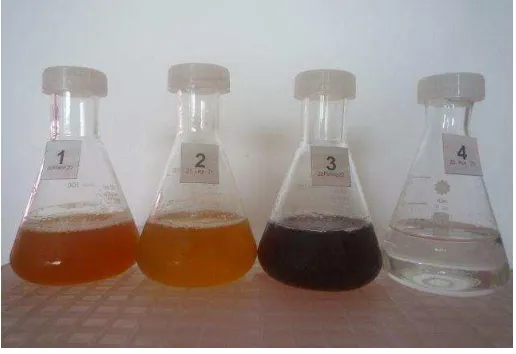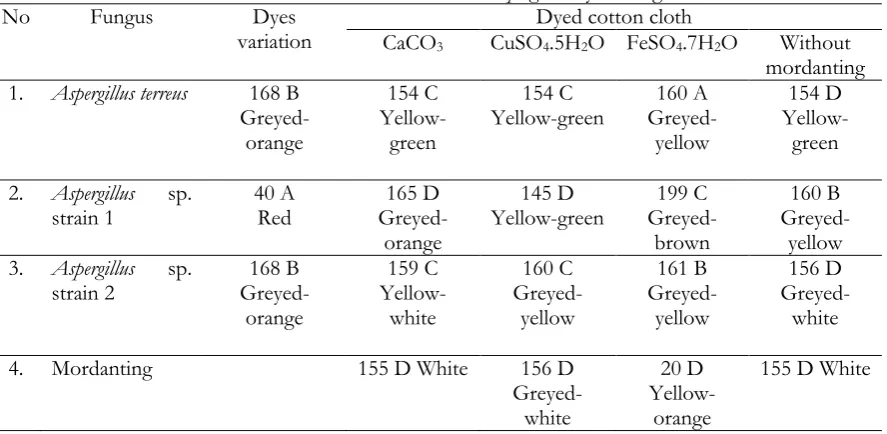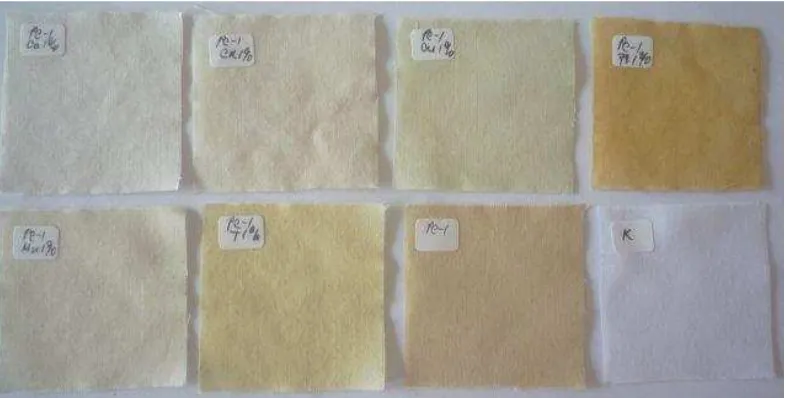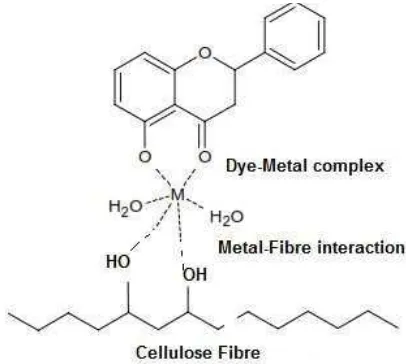19
AcehInternationalJournalofScienceandTechnology
ISSN:2088-9860 eISSN: 2503-2348 Journalhomepage:http://jurnal.unsyiah.ac.id/aijst
Effect of Different Mordants on Cotton Cloth Dyed with
Aspergillus
and
Penicillium
Dyes
Suciatmih
*, Iman Hidayat
Research Center for Biology, Indonesian Institute of Sciences, Cibinong Science Center Jl. Jakarta-Bogor Km 46 Cibinong, West Java, Indonesia
*Corresponding author, email: suciatmih2008@yahoo.com
Received : October 27, 2016 Accepted: April 19, 2017 Online : April 26, 2017
Abstract–discovery of new natural dyes is important as an alternative to environmentally harmful synthetic dyes. This research was conducted using three varieties of Aspergillus dyes and six varieties of
Penicillium dyes. In this study, Aspergillus and Penicillium isolates were grown in mineral salts glucose
medium. Pre-mordanting on cotton cloth was conducted using different mordants, namely, alum, CaCO3, CuSO4.5H2O, FeSO4.7H2O, K2Cr2O7, and MnSO4.H2O (monohydrate). The colour of filtrate and range of colours developed on dyed materials were measured by RHS colour chart. The results indicated that colour intensity on dyed cloth was influenced by the addition of mordants.Different shades were also obtained from the same dye filtrate using different mordants. Mordant FeSO4.7H2O was found as the most appropriate mordant in combination with the fungal dyes. The present study describes new sources of fungal dyes, which can be used as an environmental friendly alternative for dyeing cloth.
Keyword: Aspergillus; cotton cloth; dyes; mordant; Penicillium
Introduction
Plants and animals have been known as good sources for production of natural dyes, but the inability of them to meet the world demand has led to increased interest in synthetic dyes which can pollute environment and harmful to human health. Natural dyes exhibit better biodegradability and higher compatibility with the environment than synthetic dyes (Sivakumaret al., 2009).
These problems can be solved by exploiting several potential biological sources such as fungi, bacteria, and algae.Dyes production by microorganisms is very important to textile industries because microorganisms can grow rapidly, provide high productivity and its products are available throughout the year (Méndez et al., 2011). Microbial dyes are often more stable and soluble than those produced by plants or animals (Gunasekaran and Poorniammal, 2008).
Aspergillus and Penicilliumhave been known as fungi secreting dyes. Various natural dyes from Aspergillus
and Penicilliumwere reported. These include brownish red dye by Aspergillus sp. isolated from soil
(Anchanadevi, 2014); dark brown, brown, faint reddish brown and brown dyes byPenicilliumchrysogenum
(NRC 74), P. italicum (NRC E11), P. oxalicum (NRCM25) and P. regulosum (NRC 50), respectively (Atalla et al., 2011);greenish blue dye byP. fagi isolated from beech leaves (Martinez and Ramirez, 1978);red dye by P.
marneffei (Woo et al., 2014); andyellow, red and orange dyesby P. purpurogenum DPUA 1275
(Santos-Ebinumaet al., 2013).
20
with the dye molecule, making them insoluble in water. Common mordants include alum, chrome, stannous chloride, copper sulphate, ferrous sulphate, and so forth.
The aim of the present investigation is to evaluate various dyes produced by Aspergillus and Penicillium
isolates using different mordants in dyeing cotton cloth. This study is expected to provide colour variations from natural dyes produced by Aspergillus and Penicillium.
Materials and Methods Materials
Chemical materials used in this study include alum (KAI (SO4)2.12H2O), CaCl2. 2H2O, CaCO3, CuSO4.5H2O, FeSO4.7H2O, glucose, H3BO3, KCl, K2Cr2O7, MgSO4.7H2O, MnSO4.H2O (monohydrate), NaH2PO4, NaNO3, Na2MoO4.2H2O, Potato Dextrose Agar (PDA), and ZnSO4.7H2O,while other materials used include cotton cloth, detergent, Erlenmeyer, Petri dish, stove, and test tube.
Fungi
Three isolates of Aspergillus, namely A. terreus, Aspergillussp. strain 1, and Aspergillus sp. strain 2 (sexual morph: Emericella sp.), and six strains of Penicillium, such as Penicillium sp. strain 604, Penicilliumsp. strain 720, Penicillium sp. strain 1, Penicilliumsp. strain 3a, Penicilliumsp. strain 3b, and Penicilliumsp. strain 4uhb were used in this study.
Inoculum preparation
Each fungal isolate was grown separately in Petri dishes containing PDA medium and incubated at room temperature (27-28°C) for 5 days. Each fungal isolate was then printed with a straw of pop ice (10 mm) for further inoculation.
Liquid fermentation
Five mycelial prints of Aspergillus or Penicilliumwere inoculated separately into Erlenmeyer flask containing mineral glucose medium (Baker and Tatum, 1998). Composition of the mineral salts-glucose medium is described as follows (in ppm): NaNO3, 848; KCl, 300; MgSO4.7H2O, 165; NaH2PO4, 100; CaC12.2H2O, 40; H3BO3, 5.7; FeSO4.7H2O, 5.0; ZnSO4.7H2O, 4.4; MnSO4.H2O (monohydrate), 3.1; Na2MoO4.2H2O, 2.5; CuSO4.5H2O, 0.4; and glucose, 20,000. Mineral salts and glucose solutions were separately autoclaved, and combined after cooling in culture flasks in a sterile laminar flow hood. The Erlenmeyer containing fungal isolates were incubated at room temperature (27-28o C) in stationary cultures for 4 weeks.
Harvesting of dyes
Aspergillus andPenicillium cultures will form heavy mycelial mats floating within 2 weeks, and begin
elaborating dyes that leaked into the medium. After 4 weeks incubation period, the mycelium was harvested, and the dye was filtered in a muslin cloth for further assay.
Dyeing of cotton cloth
Dyeing of cotton cloth with dyes produced by Aspergillus and Penicilliumwas carried out in three stages as follows: 1) washing, 2) mordanting, and 3) dyeing.
Washing
To remove the wax and impurities, cotton cloth used for dyeing was first washed with detergent, rinsed with water, and then dried.
Mordanting
Mordantingwas conducted in three stages of dyeing: pre-mordanting, simultaneous mordanting, and post-mordanting. Pre-mordanting step was used due to producing brighter colour appearance in the previous study. CaCO3, CuSO4.5H2O, FeSO4.7H2O,KAI (SO4)2.12H2O, K2Cr2O7, and MnSO4.H2O (monohydrate) were used as the mordant. Before colouring process, samples of cotton cloth (5 cm × 5 cm or 0.27 g) were treated with or without pre-mordanting using 1 % of each mordant with ratio of 1: 30 (material : liquor). Mordanting process was carried out at 90º C for 5 minutes. The samples was further detached, squeezed and dyed with the different dyes extracted separately from Aspergillus and Penicillium
21
Dyeing
Cotton cloth samples were treated with the different dyes extracted from Aspergillus or Penicillium with ratio of material to liquor is 1 : 30. Dyeing process was carried out at 90ºC for 5 minutes and left overnight (Jothi, 2008 with modification). After dyeing process, the dyed clothes was rinsed with water and dried at room temperature (27-28o C). The colour that appears on the cotton clothwas measured with the RHS colour chart (Anonymous, 1966).
Results and Discussion
Variation of colours produced by A. terreus, Aspergillussp. strain 1, and Aspergillus sp. strain 2 on mineral salts glucose medium are presented in Tables 1, 2 and 3; and Figure 1. The colours produced by these three Aspergillus isolates were greyed-orange (168 B) and red (40 A). Similarcolours were also reported from other Aspergillus species such as dark red and orange-red dyes byA. glaucus and Aspergillus sp., respectively (Malik et al., 2012), brown dye by A. niger NRC 95 (Atalla et al., 2011), red dye by Aspergillus
sp. (Anchana devi, 2014), and red dye by Emericella (sexual morph of Aspergillus) (Velmurugan et al., 2010). In addition, more diverse colour variation was found from Penicillium isolates grown on mineral salts glucose medium (Tables 1, 4, 5; Figures 2, 3). Six different dyes, viz, 45 B red, 33 A orange-red, 168 C greyed-orange, 169 B greyed-orange, 168 B greyed-orange, and 187 A greyed-purple, were produced by
Penicilliumisolates.Previous studies also found similar dyes produced by Penicilliumsuch as chromophore
greenish-yellow and orange-yellow by P. caseifulvum (Suhr et al., 2002), atrovenetin yellowby P. herquei
(Robinson et al., 1992), red dye by P . marneffei (Woo et al., 2014), mitorubrin (yellow) and mitorubrinol (orange-red) by P. purpurogenum (Buchi et al., 1965), arpink red (dark red)by P. oxalicum var. armeniaca
(Sardaryan et al., 2004), red-orange and red by P. pseudostromaticum (Mahesh et al., 2014), and purpurogenone red by P. purpurogenum (Quiet al., 2010).
Table 1. Variation of dyes produced by Aspergillus and Penicillium isolates
Aspergillus Dyes produced by
Aspergillus
Penicillium Dyes produced by
Penicillium
Aspergillus terreus 168 B
Greyed-orange
Penicilliumsp. strain 604 45 B
Red
Aspergillus sp. strain 1 40 A
Red
Penicillium sp. strain 720 33 A
Orange-red
Aspergillus sp. strain 2 168 B
Greyed-orange
Penicilliumsp. strain 1 168 C
Greyed-orange
Penicilliumsp. strain 3a 169 B
Greyed-orange
Penicilliumsp. strain 3b 168 B
Greyed-orange
Penicilliumsp. strain 4uhb 187 A
Greyed-purple
22
Figure 1. Aspergillus dyes;(1)Aspergillussp. strain 2,
(2)Aspergillussp. strain 1, (3)A. terreus,(4) mineral saltsglucose
medium.
Figure 2. Penicillium dyes; (1)Penicilliumsp. strain604,
(2)Penicilliumsp. strain 720, (3)Penicilliumsp. strain 1,(4)mineral
salts glucose medium.
Figure 3. Penicillium dyes;(1) Penicilliumsp. strain3a,
(2)Penicilliumsp. strain 3b, (3)Penicilliumsp. strain 4uhb,(4) mineral
23
Table 2. Colour variation on cloth stained with Aspergillus dyes using different mordants
No Fungus Dyes
variation
Dyed cotton cloth
CaCO3 CuSO4.5H2O FeSO4.7H2O Without
mordanting
Table 3. Colour variation on cloth stained with Aspergillus dyes using different mordants
No Fungus Dyes
Mordants application on Penicilliumdyes also produced different shades on cotton cloth (Tables 4, 5).
The Penicllium dyes can stain cotton cloth from 155 D white into 76 C violet, 160 A & D; 161 A, B & D;
162 B yellow, 163 B & D; 164 C and 165 D orange, 156 D white, 199 D greyed-brown, 157 A green-white, 145 C yellow-green, 26 D orange, 159 B orange-white, 201 D grey, 159 C yellow-white, and 155 C white. The study of dyeing cloth with a Penicillium dye reported that Penicillium
spp. grown in a liquid medium produces a reddish brown colour on wool (Atalla et al., 2011).
Table 4. Colour variation on cloth stained with Penicilliumdyes using different mordants
No Fungus Dyes
variation
Dyed cotton cloth
CaCO3 CuSO4.5H2O FeSO4.7H2O Without
24
strain 720 Orange-red
Greyed-yellow
Table 5. Colour variation on cloth stained with Penicilliumdyes using different mordants
No Fungus Dyes bonding with the mordants agent and dye (Onal, 1996). This study showed that staining cotton cloth with
Aspergillus and Penicillium dyes produced different shades of the colour. The characteristics of colour
25
Figure 4. Cotton cloths dyed with A. terreus dye using different mordants; Ca = CaCO3, Cr = K2CR2O7, Cu = CuSO4.5H2O, Fe = FeSO4.7H2O, MnSO4.H2O, T =
alum, K = control.
Unmordanted cotton cloth stained with dyes from Aspergillus sp. strain 1 and Penicilliumsp. strain 1 produced bright sufficient colours. Application of mordants to the Aspergillus sp. strain 1 and Penicilliumsp. strain 1 dyes caused the colour of cotton cloth became fade (Tables 2, 3, 4, 5). The unmordanted cotton cloth stained with Aspergillus sp. strain 1 dye produced 160 B greyed-yellow colouron the cotton cloth, however, application of mordants alum, K2Cr2O7, and MnSO4.H2O to fungal dye causing the colour of cotton cloth became 156 D greyed-white. The unmordanted cotton cloth stained with Penicilliumsp. strain 1 dye produced 163 D greyed-orange colour, however, application of mordants CaCO3, K2Cr2O7, and MnSO4.H2O causing the colour of cotton cloth became 156 D greyed-white, 160 D greyed-yellow, and 160 D greyed-yellow, respectively (Figure 5). This evidence showed that metal complex formation for these dyes did not improve the colour intensity on the cotton cloth.
Figure 5. Cotton cloth dyed with Penicilliumsp. strain 1 dye using different mordants;Ca = CaCO3, Cr = K2CR2O7, Cu = CuSO4.5H2O, Fe = FeSO4.7H2O, MnSO4.H2O, T = alum, K
= control.
Dyed cotton cloth using dyes from Penicilliumsp. strain 604 and Penicilliumsp. strain 720 treated with mordants did not show difference with the dyed cotton cloth without mordanting. Distinct colour to the cotton cloth stained with Penicilliumsp. strain 604 and Penicilliumsp. strain 720 dyes was found when FeSO4.7H2O was applied as mordant. Similar colour was also found in the cotton cloth stained with
26
mordanting. Another similar colour was also found between the cotton cloth stained using Penicilliumsp. strain 4uhb dye treated with mordants (except CaCO3 and FeSO47H2O) and the cotton cloth without mordanting. These data showed that metal complex formation for these natural dyes did not improve the colour on the cotton cloth.
Different types of mordant added to the same natural dye produced by Aspergillus spp. or Penicillium
spp. may drastically alter the colour and influence the shades of the final cotton cloth colour which may be a desired effect or an unwanted result. Similar result reported that different shades obtained from natural dye extracted from the flowers of Tecomastanswhen applyingdifferent mordants like copper sulphate, ferrous sulphate, ferric chloride, potassium dichromate, myrobolon, and cow dung (Chandra Mohan et al., 2012).Uddin (2014) also noted that depending on the metal character of mordants, the complex formation not only strengthens dye fixation on the substrate but also changes the colour of dyeing.
Based on the variation in colour intensity on dyed cotton cloth treated with pre-mordanting process using alum, CaCO3, K2Cr2O7, CuSO4.5H2O, FeSO4.7H2O, and MnSO4.H2O, the sequence of colour from highest to lowest were FeSO4.7H2O>CuSO4.5H2O or alum > CaCO3 > MnSO4.H2O or K2Cr2O7. The colour intensity gradually decline from FeSO4.7H2O to MnSO4.H2O or K2Cr2O7. Application of mordant FeSO4.7H2O to the Aspergillus and Penicillium dyes produce darker or brighter colour to the cotton cloth than application of the other mordants. Previous study also found that addition of pre-mordantingFeSO4 in natural dyes (onion extracts) produced darker final colour (Uddin, 2014). Application of alum as mordant agent produced stronger colour intensity to five fungal natural dyes from A. terreus, Aspergillus sp. strain 2, Penicilliumsp. strain 1, Penicilliumsp. strain 3a, and Penicillium sp. strain 3b. Application of CuSO4.5H2O to the dyes produced by five isolates, namely A. terreus, Aspergillus sp. strain 1, Aspergillus sp. strain 2, Penicilliumsp. strain 1, and Penicilliumsp. strain 3a also produced stronger colour intensity to the cotton cloth. In addition, mordant CaCO3 produces stronger colour to the cotton cloth stained by dyes from four isolates, namely A. terreus, Aspergillus sp. strain 1, Penicilliumsp. strain 3a, and Penicilliumsp. strain 4uhb. K2Cr2O7 and MnSO4.H2Omordanting agents produced stronger colour on the cotton cloth stained by three dyes, namely A. terreus, Penicilliumsp. strain 3a, and Penicilliumsp. strain 3b.
Mordants play very important role in imparting colour to the cotton cloth in the form of metal complex formation which results in increase of dye uptake. This is attributed to the fact that the metal ions of mordants act as electron acceptors from groups of dye donating electron to form co-ordination bonds with the dye molecule, making them insoluble in water (Mongkholrattanasitet al., 2011). Kamelet al.
(2009) also reported that colour strength are dependent on the metal salt used. There was tendency of Fe make a strong coordination, therefore, enhances the interaction between fiber and the dye, resulting in a greater depth of shades(Jothi, 2008; Tripathiet al., 2015). For example, FeSO4.7H2Ohas the ability of forming coordination complexes. Functional group as hydroxy on the cotton cloth can occupy the unoccupied sites on metal ion interaction with the dye. Thus, a tenary complex is formed by the metal salt on which one site is with the cotton fiber and the other site is with the dye (Mongkholrattanasitet al., 2011) (Figure 6). The current study aslo showed that the cotton cloth mordanted with FeSO4.7H2O showed comparatively a good colour yield (Figures 4, 5).
27
Conclusions
This study showed that nine selected fungal isolates, namely A. terreus, Aspergillus sp. strain 1, Aspergillus
sp. strain 2 (sexual morph: Emericella), Penicilliumsp. strain 604, Penicilliumsp. strain 720, Penicilliumsp. strain
1, Penicilliumsp. strain 3a, Penicilliumsp. strain 3b, and Penicilliumsp. strain 4uhb produced natural dyes that
can be used to dye textile.Cotton cloth mordanted with FeSO4.7H2Oexhibited comparatively a good colour yield.
References
Anchanadevi, A. 2014. Extraction of natural dyes from fungus – An alternate for textile dyeing.Journal of Natural Sciences Research, 4(7): 1-6.
Anonymous.1966. R.H.S. Colour Chart.The Royal Horticultural Society. London.
Atalla, M.M., El-khrisy, E.A.M., Youssef, Y.A. and Mohamed, A.A. 2011. Production oftextile reddish brown dyes by fungi. Malaysian Journal of Microbiology, 7(1):33-40.
Baker, R.A. and Tatum, J.H. 1998. Novel anthraquinones from stationary cultures ofFusarium oxysporum. Journal of Fermentattion and Bioengineering, 85(4): 359-361.
Büchi, G., White, J.D. and Wogan, G.N. 1965. The structures of mitorubrin and mitorubrinol. Journal of the American Chemical Society, 87: 3484-3489.
Chandra Mohan, S., ThiripuraSalini, S., SenthilKamar, R. and Thiyagarajan, A. 2012. Dyeing of cotton with natural dyes obtained from flower of Tecomastans. Universal Journal of Environmental Research and Technology, 2(1): 41-46.
Gunasekaran, S. and Poorniammal, R. 2008. Optimization of fermentation conditions for red pigment production from Penicilliumsp. under submerged cultivation. African Journal of Biotechnology, 7(12): 1894-1898.
Jothi, D. 2008. Extraction of natural dyes from African marigold flower (Tageteserecta L.) for textile coloration. Autex Research Journal, 8(2): 49-53.
Kamel, M.M., Helmy, H.M. and Hawary, N.S. 2009. Some studies on dyeing properties of cotton fabrics with Crocus sativus (Saffron) flowers using an ultrasonic method. AUTEX Research Journal, 9(1): 29-35.
Kechi, A., Chavan, R.B. and Moeckel, R. 2013. Ethiopian dye plants as a source of natural dyes for cotton dyeing. Universal Journal of Environmental Research and Technology, 3(4): 501-510.
Mahesh, J., Kamat, S.D. and Kamat, D.V.2014.Fungal pigment characterization and application.Bionano Frontier, 7(1): 34-40.
Malik, K., Tokkas, J. and Goyal, S. 2012.Microbial Pigments: A review. International Journal of Microbial Resource Technology, 1(4): 361-365.
Martinez, A.T. and Ramirez, C. 1978. Penicilliumfagi sp. nov., isolated from beech leaves. Mycopathologia, 63: 57-59.
Méndez, A., Pérez, C., Montañéz, J.C., Martínez, G. and Aguilar, C.N. 2011. Red pigment production by
Penicilliumpurpurogenum GH2 is influenced by pH and temperature. Journal of Zhejiang University
Science B, 12(12): 961-968.
Mongkholrattanasit, R., Krystufek, J., Wiener, J. and Vikova, M. 2011. Dyeing, fastness and UV protection properties of silk and wool fabrics dyed with Eucalyptus leaf extract by the exhaustion process. Fibers and Textiles, 19(3): 94-99.
Onal, A. 1996.Extraction of dyestuff from onion (Allium cepa L.) and its application in the dyeing of wool, feathered-leather and cotton.Turkish. Journal of Chemistry, 20: 194-203.
Qui, M., Xie, R., Shi, Y., Chen, H. and Wen, Y. 2010.Isolation and identification of endophytic fungus SX01, a red pigment producer from Ginkgo biloba L. World Journal of Microbiology and Biotechnology, 26: 993-998.
Robinson, N., Wood, K., Hylands, P.J. and Gibson, T.M. 1992. Blue pigments of Penicilliumherquei. Journal of Natural Products, 55: 814-817.
Sangeetha, K., Gomathi, R. and Bhuvaneshwari, M. 2015. Dyeing of silk fabric using lemon leaves extract with the effect of different mordants. International Journal of Innovative Research in Science, Engineering and Technology, 4: 4692-4697.
28
Sardaryan, E., Zihlova, H., Strnad, R. and Cermakova, Z. 2004. Arpink Red –meet a new natural red food colorant of microbial origin. In: Pigments in Food, More than Colours. Dufossé, L., (ed) Université de Bretagne Occidentale, Quimper France, pp. 207-208.
Satyanarayana, D.N.V. and Chandra, K.R. 2013. Dyeing of cotton cloth with natural dye extracted from Pomegranate peel and its fastness. International Journal of Engineering Sciences and Research Technology, 2(10): 2664-2669.
Sivakumar, V., Lakshmi, A. J., Vijayeeswaree, J. and Swaminathan, G. 2009. Ultrasound assisted enhancement in natural dye extraction from beetroot for industrial applications and natural dyeing of leather. UltrasonicsSonochemistry, 16: 782–789.
Suhr, K.I., Haasum, I., Steenstrup, L.D. and Larsen, T.O. 2002. Factors affecting growth and pigmentation of Penicilliumcaseifulvum.Journal of Dairy Science, 85: 2786-2794.
Tripathi, G., Yadav, M.K., Upadhyay, P. and Mishra, S. 2015. Natural dyes with future aspects in dyeing of textiles: A research article. International Journal of PharmTech Research, 8(1): 096-100.
Uddin, M.G. 2014. Effects of different mordants on silk fabric dyed with onion outer skin extracts. Journal of Textiles, article ID 405626, pp. 1-8. http://dx.doi.org/10.1155/2014/405626.
Velmurugan, P., Kamala-Kannan, S., Balachandar, V., Lakshmanaperumalsamy, P., Chae, J.C. and Oh, B.T. 2010.Natural pigment extraction from five filamentous fungi for industrial applications and dyeing of leather. Carbohydrate Polymers, 79: 262-268.





